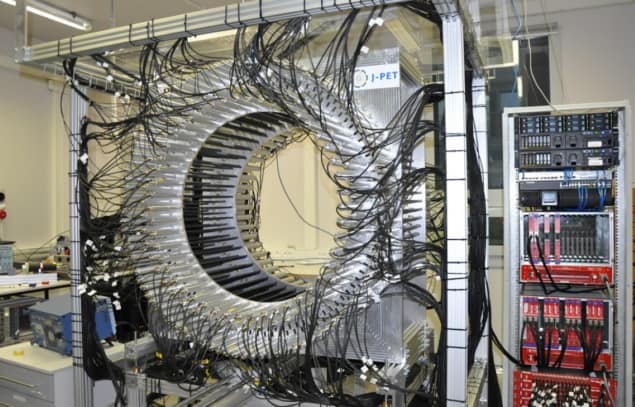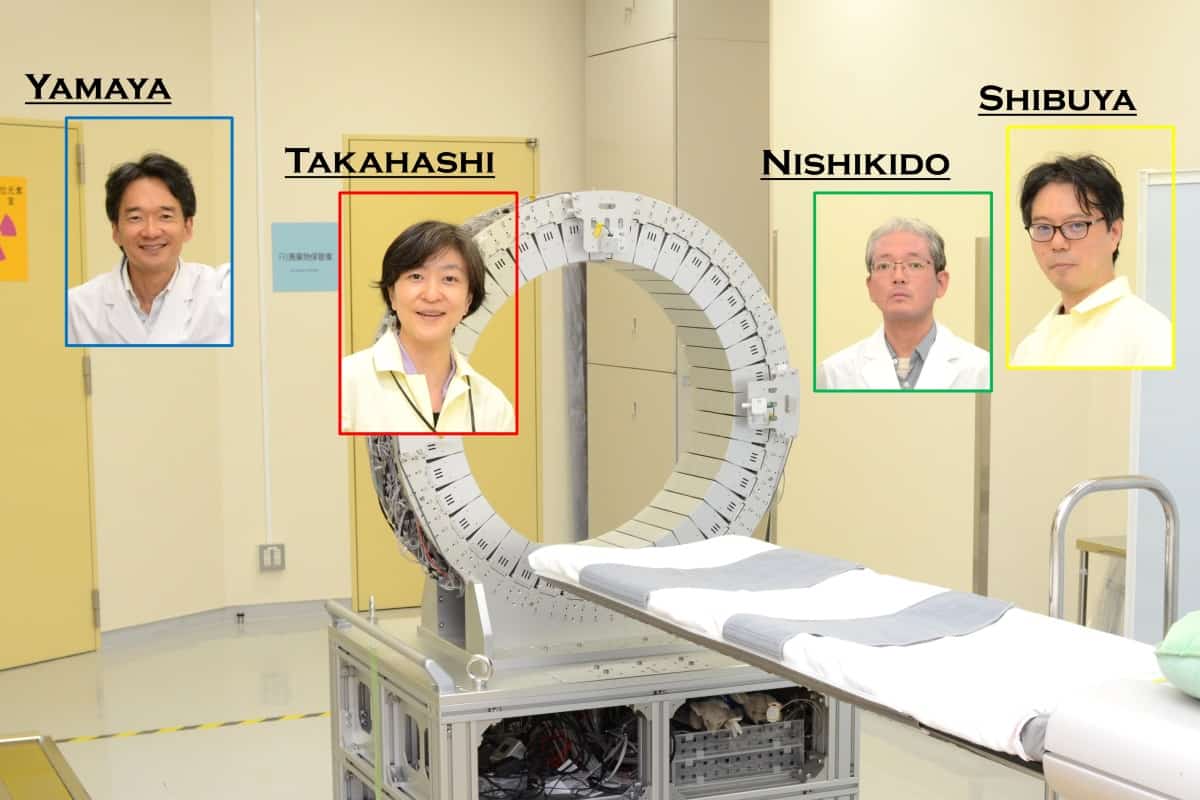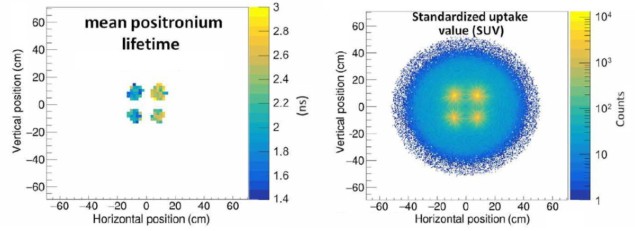First positronium image recorded during a PET scan
21 Oct 2021 Tami Freeman
Positron emission tomography (PET) is a molecular imaging method used for cancer diagnosis. During the imaging procedure, positronium is also generated in the patient’s body, but current PET systems are not able to acquire positronium images. Now, researchers in Poland have created the first-ever positronium image recorded during a PET scan, reporting their results in Science Advances.
“Our goal in introducing positronium imaging is to increase the specificity of cancer diagnosis such that one can determine the degree of cancer malignancy in vivo without the need for surgical biopsy,” explains co-first author and inventor of the positronium imaging Paweł Moskal from Jagiellonian University.
“We believe that the positronium image will enable better distinction between the healthy, cancer and inflammatory tissues and that it will enable us to determine the degree of a tumour’s malignancy,” adds Ewa Stępień, the head of medical research in the group.
During PET scanning, positrons emitted from an injected radionuclide annihilate with electrons in the patient’s tissue and release a characteristic pair of 511 keV photons. This positron–electron annihilation may proceed directly or, in almost 40% of cases, via the formation of an intermediate positron–electron bound state, known as positronium.
Three quarters of the positronium formed is ortho-positronium (o-Ps), which decays into three photons after a mean lifetime (in vacuum) of 142 ns. In tissue, this lifetime is significantly shorter (roughly 1.8 to 4 ns) due to processes such as annihilation of an o-Ps positron with an electron from a surrounding molecule (pickoff) or interaction with oxygen or other biomolecules converting the o-Ps to para-positronium.
These pickoff and conversion processes make the mean o-Ps lifetime highly sensitive to the size of inter- and intramolecular voids and the concentration of biomolecules within them. As such, measurements of positronium lifetime may reveal tissue alterations at the molecular level, providing important information about early-stage disease progression.
Triple coincidence
Moskal and colleagues have developed a method for positronium lifetime imaging using the Jagiellonian-PET (J-PET) scanner. The J-PET scanner incorporates 192 plastic scintillator strips arranged in concentric layers and read out by photomultipliers connected at both ends. To create a positronium image, the system examines triple coincidence events corresponding to the registration of two annihilation photons and one prompt gamma photon.
“PET scanners are usually designed to register two photons from the positron–electron annihilation,” explains co-first author Kamil Dulski. “The J-PET system is designed for simultaneous registration of both the photons from the annihilation process and photons emitted by the radionuclide.” Full-scale prototype: The Jagiellonian-PET detector is made of three cylindrical layers of plastic scintillator strips (black) and vacuum tube photomultipliers (grey). (Courtesy: Kamil Dulski, Jagiellonian University)
Full-scale prototype: The Jagiellonian-PET detector is made of three cylindrical layers of plastic scintillator strips (black) and vacuum tube photomultipliers (grey). (Courtesy: Kamil Dulski, Jagiellonian University)
 Full-scale prototype: The Jagiellonian-PET detector is made of three cylindrical layers of plastic scintillator strips (black) and vacuum tube photomultipliers (grey). (Courtesy: Kamil Dulski, Jagiellonian University)
Full-scale prototype: The Jagiellonian-PET detector is made of three cylindrical layers of plastic scintillator strips (black) and vacuum tube photomultipliers (grey). (Courtesy: Kamil Dulski, Jagiellonian University)To test the new imaging technique, the researchers created a phantom comprising samples of tumour and adipose tissue excised from two patients. Each of the four samples was inserted into a holder along with a radioactive 22Na source, and inserted into the J-PET tomographic chamber. The 22Na acts as the source of positrons for the experiment, and also emits a 1.27 MeV prompt gamma ray with each decay.
The team used the interaction times and positions of the annihilation photons in the scintillator strips to reconstruct the annihilation rate distribution, which is an analogue of the standardized uptake value (SUV) in a conventional PET image. In this set-up, this SUV image reflects the geometrical configuration of the tissue samples and the activity of the 22Na sources.
Next, the researchers reconstructed the prompt gamma emission times, which are near-equivalent to the times of positron emission and positronium formation. For every voxel of the SUV image, they determined the difference between the annihilation time and the time of positron emission. They then used these time difference distributions to determine the mean o-Ps lifetime on a voxel-by-voxel basis, thereby creating a positronium mean lifetime image.
“Reconstruction of the positronium image required development of novel data analysis and image reconstruction methods that enable simultaneous reconstruction of a standard PET metabolic image and the positronium image,” notes Dulski.READ MORE

The researchers observed visible and significant differences between the o-Ps lifetime in cancerous and healthy tissues, with mean lifetimes of approximately 1.9 ns in the tumour samples and 2.6 ns in the adipose tissues. This finding suggests that images of positronium mean lifetimes could indeed provide a means for in vivo cancer classification and serve as a virtual biopsy, says Stępień.
The next step of the project, says Moskal, will be to construct a high-sensitivity total-body J-PET scanner and perform positronium imaging in vivo. “The J-PET tomography system based on low-cost plastic scintillators enables about five-fold cost reduction [over crystal-based technology] when building a total-body PET scanner,” he tells Physics World. “J-PET technology constitutes a realistic, cost-effective total-body PET solution for broad clinical applications.”
from physicsworld.com21/10/2021

Δεν υπάρχουν σχόλια:
Δημοσίευση σχολίου